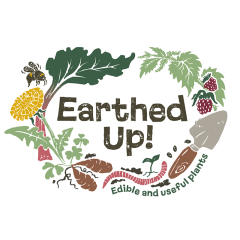We stock peat free compost – Melcourt SylvaGrow and Dalefoot wool compost. You can order by email and collect or we deliver to Belper, Derbyshire and surrounding towns and villages.
You can buy peat free compost from Earthed Up! in Derbyshire. Which to use, though? In this post, Ryan runs through some of our comparisons to help you decide which compost to use.
Seed starting
We use: SylvaGrow organic multipurpose.
DIY
A classic mix is 1/3 each of garden soil, sharp sand and leaf mould. You need to have prepared a year or more ahead of time for the leaf mould and buy in or source the sand.
You can also of course simply use your own homemade compost. Pitfalls may include persistent weed seeds and soil dwelling creatures that inhibit growth of the seeds or eat the seedlings – parasitic nematodes and small slugs in particular come to mind.
With using homemade compost for seed starting, sieving may improve results, particularly for smaller seeds.
The bought options
Multipurpose compost is typically suitable for starting seeds and for propagating cuttings.
Specialist seed composts exist, usually with added sand or grit to aid drainage – too much moisture can rot some seeds.
Unless it’s particularly warm, seed trays will just need watering once when sown, then not again until the seedlings come up.
Seed compost is formulated to have just enough nutrients for the first stages of growth, so they lack fertility for growing on. You need to prick out seedlings into another compost suitable for potting.
Potting on
We use: a custom blend, of SylvaGrow organic multipurpose, plus vermicompost, and biochar – this keeps our plants growing well and healthy in pots for sustained periods.
Potting on is taking seedlings from their module tray or seed tray into small pots before planting out in the garden when they’re bigger. Plants are happiest in the ground, so don’t leave them in pots for too long.
This is a time of vital growth for the seedling, as it develops ‘true leaves’ and a more complex root system. So, texture and nutrients are important in a potting mix. You also want the compost to drain so that the fungi that causes damping off doesn’t flourish.
DIY
You could use well aged homemade compost, maybe with 10% sharp sand added. Horticultural sand is available and it’s washed to ensure very low or zero salt.
We use vermicompost from our worm farms because of the concentrated fertility and rich biology. Learn more about making your own compost with our Soil Health Clubs.
The bought options
Container plants
We use: A combination of SylvaGrow multipurpose, own made cold compost, and biochar. Mulching with woodchip retains moisture.
DIY
If the plants are going to find their forever home (or at least quite-a-while home) in a pot, then arguably this is the most important scenario where quality compost is key.
There are factors to consider here beyond what compost you use, including drainage, irrigation, protection from frost and more. We’re focusing on compost in this post.
For healthy plants, you need a healthy soil food web. A pot is a microcosm of that soil ecosystem. So, how can we create a good soil environment in a pot? I think diversity and balance are two principles to focus on.
Diversity: a rich diversity of ingredients and nutrients, to feed a diversity of soil life, which in turn deeds the plants. One way Nature provides abundance in a forest each year is through dropping of leaves, a massive feast for the soil and the minibeasts who live in it.
Balance: can you strike the right balance of texture, nutrients and how/when they’re released, and moisture retention? To do so, diversity may help! And gardening with potted plants can be quite forgiving, in that you can move them, soak their roots with water or liquid feed, and you can repot them. So, I say don’t be too cautious in trying something new.
The bought options
See more on @LymWild’s trials on Twitter.
Thinking on diversity again, Dalefoot include a mix of renewable natural ingredients in their composts, including composted wool of course, bracken and comfrey. This mix is so effective at feeding over time that they say there is “No need to feed – None of our composts require any additional feed and will feed your plants throughout the season.”
Buy peat free compost in Derbyshire
We stock Melcourt SylvaGrow organic multipurpose potting media. We stock Dalefoot wool compost – for vegetables and salads, for tomatoes, double strength, and Lakeland Gold.
Find full information and place your order today to grow in some of the best stuff on the market.



One thought on “Compost comparisons – what compost to use for sowing seeds and plants in pots?”